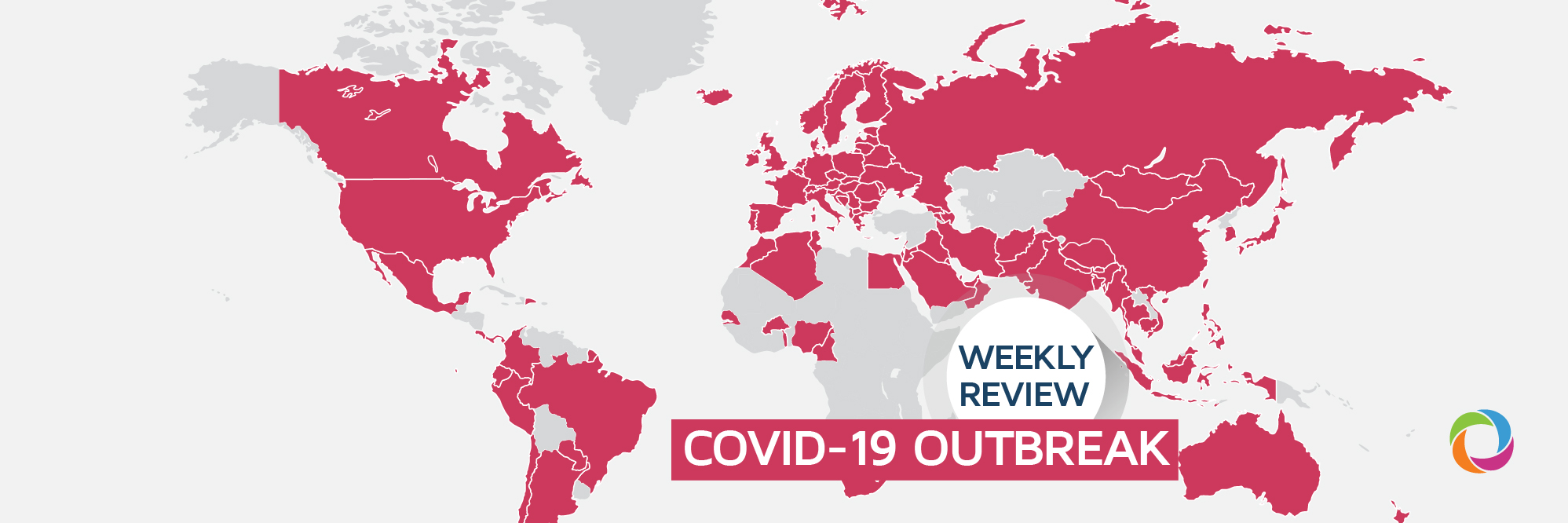Weekly review of the coronavirus situation across the world, prepared by DevelopmentAid
(March 3 – 10, 2020)
As of March 10, over 113,000 people across more than 100 countries worldwide have been diagnosed with the COVID-19 coronavirus. Since last Tuesday, March 3rd, over 23,000 new confirmed cases have been reported, with around 17,000 patients recovering during the same period. The pattern of more quickly growing “new confirmed” cases versus “recovered” patients has been recorded following two consecutive weeks of an apparent retreat of the COVID-19, according to the data provided by the Coronavirus COVID-19 Global Cases mapping by Johns Hopkins University.
On March 7th, the World Health Organization reported that the number of COVID-19 patients globally had passed the 100,000 mark. Today, the virus has been confirmed in 109 countries (more than half the world), 37 countries having been added to the list since last week’s DevelopmentAid report. Of the total infected patients, almost 32,000 are reported as being from outside China where the virus first broke out in December 2019.
With more than 65,000 patients having recovered, the number of those who have died had risen to 4,012 people as of March 10, an increase of almost 750 since our last review. The grim statistics show that nearly 3,140 deaths have been recorded in China, followed by Italy where 463 people have died and Iran with 237 deaths caused by COVID-19 according to the WHO.
The risk of the spread and the impact of the COVID-19 remains “very high” across the globe.
The economic impact of the COVID-19
The impact of the COVID-19 outbreak on the world economy has been an important topic in international news.
ADB, the Asian Development Bank, has raised concerns about the significant impact of the COVID-19 virus for developing Asian economies. Thus, in an analysis made public last week, the organization predicts sharp declines in domestic demand, lower tourism and business travel, trade and production co-operation, supply disruptions and health effects. Expressed in US$ billion, the impact will be in the range of $77 billion to $347 billion, or 0.1% to 0.4% of global gross domestic product (GDP).
The World Bank (WB) group has also announced its support to the private sector affected by the COVID-19 outbreak. International Finance Corporation (IFC), WB’s private sector arm, will provide its clients with the necessary support to continue operations and to sustain jobs, according to its press release. One of the largest international donors has not yet made public its assessment of the impact of the COVID-19 on the global economy. However, it has announced that up to US$6 billion from the IFC budget is to be allocated to assist businesses. IFC will mainly work with commercial bank clients to expand trade finance and working capital lines. It will also directly support its corporate clients.
The International Monetary Fund (IMF) has announced its readiness to make available up to US$50 billion to help address coronavirus. Kristalina Georgieva, IMF managing director, stated that the outbreak affects significant elements of both supply and demand. “Experience suggests that about one-third of the economic losses from the disease will be direct costs: from loss of life, workplace closures and quarantines. The remaining two-thirds will be indirect, reflecting a retrenchment in consumer confidence and business behavior and a tightening in financial markets,” concluded Mrs. Georgieva. For low-income countries, the IMF has rapid-disbursing emergency financing of up to $10 billion (50% of the quota for eligible members) that can be accessed without a fully-fledged IMF program.
World quarantine
Over 360 million students worldwide have stopped attending classes as a result of school closures. Fifteen countries, including China, Japan, Iran and the Republic of Korea, have announced countrywide closures. At the same time, authorities from the United States, France, Germany, Greece and another ten countries have resorted to localized school closures, according to UNESCO.
In its Strategic Preparedness and Response Plan, drafted at the beginning of February, the WHO called for US$675 million to support the most vulnerable countries against the COVID-19 outbreak. US$61.5m of this amount is intended for the WHO’s urgent preparedness and response activities for the period from February to April 2020. So far, the organization has received US$30.3 million from Australia, Canada, the Czech Republic, France, Ireland, Italy, Norway, Slovakia, the United Kingdom and the United States. The Bill and Melinda Gates Foundation and Vital Strategies have also contributed to the WHO’s response plan.
The European Commission has also announced its decision to step up research funding. Thus, an additional EUR 37.5 million has been secured which has allowed for 17 research projects to be selected involving 136 researchers. Teams from across the EU and beyond will begin working on developing vaccines, new treatments, diagnostic tests and medical systems aimed at preventing the spread of the coronavirus. The funds come from the Horizon 2020 program.
Meanwhile, the procurement process for the COVID-19 related projects is available through the developmentaid.org platform.
Stay tuned for the next DevelopmentAid Weekly Review of the coronavirus situation across the world to be released on March 17th. Subscribe to our newsletter and learn more about the coronavirus outbreak and the efforts of the international development community to tackle it.
About COVID-2019
Coronaviruses are a large family of viruses that are common in many different species of animals including camels, cattle, cats and bats. Rarely, animal coronaviruses can infect people and then spread between them such as was the case with MERS (2012) and SARS (2003). The symptoms of the virus are very similar to those of a common cold – runny nose, headache, cough, sore throat, fever, a general feeling of being unwell. Blood tests are necessary in order to prove the presence of the virus in the organism.
Named by scientists as the “Wuhan seafood market pneumonia virus”, 2019-nCoV is a coronavirus, like MERS and SARs, all of which have their origins in bats. Initial reports show that, in the early stages of the outbreak (early January 2020), many of those infected in Wuhan had some link to a large seafood and live animal market – the Huanan Seafood Wholesale Market, mainly its western wing where wildlife animals are traded. This suggests that the virus initially affected an animal and subsequently spread to a person in a what a CDC has called “the species barrier jump”.


